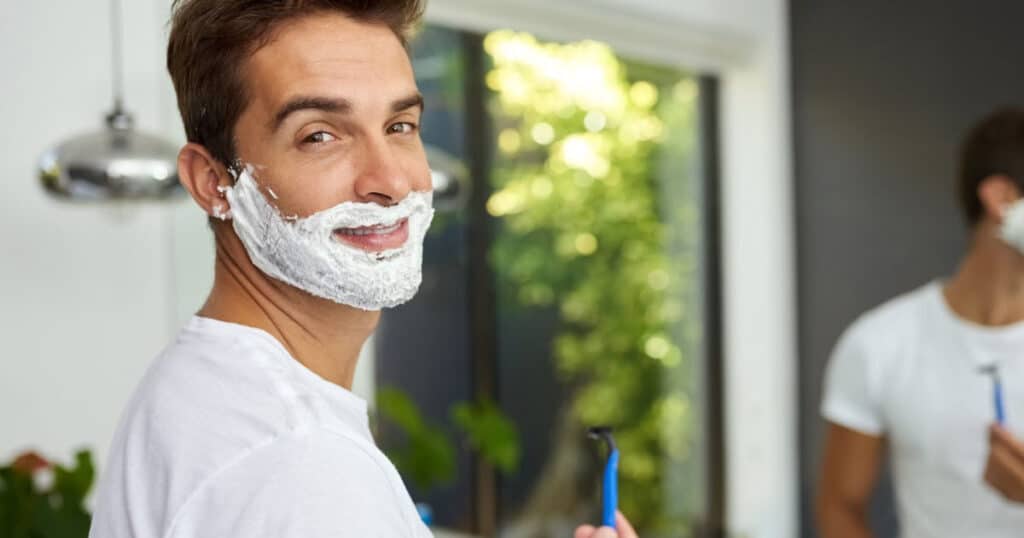Welcome! In this post, we’ll provide our two cents about dry shaving, and how it compares to wet shaving. There’s plenty of material online dedicated to wet shaving but very little that explores dry shaving, so hopefully we’ll be able to shed some light on the topic.
Some Terminology
Before we jump into the wet shaving vs. dry shaving debate, we should dictate some terms. A lot of men have slightly different definitions of wet shaving, and we’ll say that *most* men can’t really agree on the definition of dry shaving, so let’s define some of the words we’ll be using:
Wet shaving is the use of oils and balms (to prepare the face for shaving), all-natural creams and soaps (to build a lather), old-school shaving devices like straight razors and safety razors (to remove whiskers). There are other pieces of equipment involved—shaving bowls, strops for straight razors, and so on—that are unique to wet shaving, but there is also a consistent technique to wet shaving: wet shavers usually shave with the grain, across the grain, and then against the grain, in order to get an extremely close shave.
Dry shaving can be broadly defined as shaving without the use of water.* There are two main ways to dry shave: you can use a disposable razor, safety razor, or straight razor directly against the skin, without soaps or creams or gels to make a lather; or, you can use an electric razor that doesn’t require soaps or creams. That last definition—using an electric shaver without water—is perhaps the most common understanding of dry shaving. We’ll discuss both of these practices below.
*We just wrote that “dry shaving can be defined as shaving without any water.” There’s one other definition of dry shaving that’s less commonly used, and it’s the opposite of wet shaving: if “wet shaving” is using all-natural soaps and safety razors / straight razors, then “dry shaving” is using canned creams and gels and disposable razors. Plenty of guys define dry shaving that way, but for this post, we’ll simply assume that dry shaving is shaving without water.
OK! Now we know what we’re talking about. So let’s jump into…

The Good and the Bad: Dry Shaving
We’ll start with the best aspects of dry shaving:
It’s Quick. There are a couple of different “pros” of dry shaving, but the biggest advantage of dry shaving over wet shaving is that it’s quick. It takes very little time to complete a dry shave, whereas wet shaving can take you a little while. A couple of quick passes with an electric shaver, and you’re good to go. You don’t need to prep your skin, build up a lather, or do multiple passes—you bring blade to face, and then you’re done.
It’s Portable. This is advantage is particular to electric shavers: they’re easy to throw in a bag (and that makes them great for traveling), and you can even use them as you’re traveling: if you’ve ever been driving to work, and you look over in traffic, and there’s a guy going over his face with a rotary electric (those are the shavers that have the circular areas on the head that contain the blades), you know what we’re talking about. You can’t do that as a wet shaver—you need to be stationary in front of a mirror at all times.
It Doesn’t Involve Much Gear. Another bonus. All you need is a razor or an electric shaver, and you’ve got all you need to remove the whiskers from your face.
So those are the big three “pluses” of dry shaving. There are some real negatives to dry shaving, though, and they are:
It Can Be Brutal on Your Skin. Using an electric shaver can cause a LOT of skin irritation, and using a razor—particularly those disposables that have two or three or more blades—can do the same. Those tools remove hairs using a process called “shaving hysteresis,” where in a razor pulls at the whisker before cutting it. With an electric razor, one of the blades will lift the whisker a little bit, and then another razor will cut it; with a multiple-blade disposable, the first blade pulls on a hair a little bit, and the second and third razor cuts it. It works, but a lot of men experience irritation, razor burns, and red bumps because of hysteresis. Because wet shavers use only a single blade, shaving hysteresis is not involved, and the result is a lot less skin irritation. Believe it or not, many men get into wet shaving not because they’re interested in trying a more “nostalgic” form of shaving, but because electric shavers and disposable blades were causing endless bumps and razor burn.
It Doesn’t Provide a Close Shave. In a head-to-head battle of “What Technique Provides the Closer Shave?” wet shaving wins 100 times out of a 100. Some electric shavers provide a decent shave, but there’s simply no contest when it comes to three passes during wet shaving vs. the single passes involved in dry shaving.
Keep in mind, the main goal of dry shaving isn’t a super-close shave: for most men who dry shave, the reason they dry-shave is because it’s QUICK. That really is the biggest advantage of dry shaving over wet shaving.
OK, so let’s take a closer look at wet shaving.
The Good and the Bad: Wet Shaving
The first advantage is probably the biggest:
It Works! It provides an incredibly close shave. Every step of the wet shaving process is designed to maximize the effectiveness of the shave: pre-shave oils and lather open your pores and relax your skin, making whisker removal less damaging to the epidermis; the blades on straights and safety razors are unbelievably sharp, and made specifically to remove facial hairs; and the balms and after-shave products contain nutrients and minerals that keep your skin healthy and youthful-looking. When combined with the three passes that wet shavers complete—one with the grain of the whiskers, one across the grain of the whiskers, and then one against the grain of the whiskers—the result is facial skin that’s as smooth as silk.
And that’s especially true for men who have thick facial hair. If we had a nickel for every time a guy with thick facial hair said “I’ve been using disposables all my life, and I never realized how lousy they were…” we’d be rich.
Not only does it work, though—you get a very close shave—it’s better for your appearance. A close shave means you’re less likely to get that 5 o’clock shadow happening at some point during the day, and that’s actually an issue for electric shavers. Because you’re never really getting a perfect shave, those whiskers are quickly on their way back.
If “quality of shave” were the only issue in the “wet shaving vs. dry shaving” debate, wet shaving would win every time.
It’s Enjoyable. For many men, shaving is a chore. Something you hurriedly do before dashing out the door on your way to work. It’s a bothersome task that you have to complete, every day, for the rest of your life. It’s a burden.
Wet shaving changes all that, though, and makes each step of the shaving process becomes a unique and enjoyable ritual, with tools specifically selected for the task. Pre-shave oils smell great, and benefit the skin; the soaps and creams used to create a lather are soft and warm and comforting; and the safety razors and straight razors used are objects of art that look great, have a satisfying weight, and do an incredible job. The entire process, instead of being cumbersome, becomes enjoyable. For a lot of us, making a chore into something enjoyable is pretty fantastic.
Plus—there’s something nostalgic, and romantic, and manly, about wet shaving. It’s a throw-back to a previous era, and that’s enjoyable in-and-of-itself.
It Saves Money in the Long Run. Believe it or not, wet shaving is good for the wallet. While the initial expenses are a little greater—buying a safety or straight, a shaving brush, scuttle, etc.—those are items that never need to be replaced. Buying and throwing out disposable razors for the rest of your life eventually adds up (and it’s a lot worse for the environment—all that trash goes into our landfalls and sits there for centuries). Why not save a little money?
All that said, wet shaving isn’t perfect. Here are the cons:
It Takes a Little Bit of Time. We mentioned this above: wet shaving definitely adds 10+ minutes to your morning routine. Not everyone has a lot of time in the morning—particularly those of us with families, who are trying to get the kids out the door and to school—and any activity that adds extra time to the morning routine is a no-go.
That’s why there are plenty of guys who do both: they use an electric shaver or a disposable razor + canned shaving cream combo during the week, and then on the weekends, take their time and enjoy a relaxing wet shaving routine.
It Can Be Intimidating. If you’re used to disposable razors, that jump to a single-edge or double-edge safety razor can be a little bit scary. For the first time, you’re shaving with an actual razor, and—we’re going to be straight-up honest—most new wet shavers experience a bunch of nicks and cuts as they’re getting the hang of the new blade. That’s a little scary for some folks (even though most guys get the hang of it, and wet shave with few-to-none nicks).
You Need a Lot of Gear. If you travel a lot, of if your living situation is very tight—maybe you share a bathroom with roommates or a romantic partner—it can be difficult to maintain the gear needed for wet shaving. That’s actually a pretty common issue for a lot of wet shavers, and we’ve actually written a number of posts on how to make the best use of your bathroom space, whether it’s at home or on the road.

You Do You… But Definitely Give Wet Shaving a Try
So, given all the pros and cons for each style of shaving, what’s our recommendation?
Here’s how we’d approach it: if the #1 priority in your life is speed—that is, minimizing your morning routine, so that you can spend your time doing other things—then dry shaving is a perfectly acceptable routine. There are a LOT of guys who need every minute of every day, and we’d never begrudge them that. If you are dealing with a brutal schedule a close shave isn’t that important (and for many men, it’s not), dry shaving is an excellent choice.
If, however, you’re concerned with the quality of your shaving, maintaining healthy skin, and making the actual process of shaving enjoyable and pleasant, we’d urge you to check out wet shaving. Maybe we’re biased (OK, we’re very biased), but wet shaving has been one of the consistently enjoyable pleasures in our lives, and we’re here to spread the good word about it. It’s comforting, effective, and worth the effort.
Wrapping Up the Wet vs. Dry Debate
Thanks for reading! There aren’t too many posts that explore dry shaving, so we’re glad we could contribute to the discussion. Have fun, and be good!
Michael Morris is the head writer here at Rough and Tumble Gentleman. He's got a ducktail beard and loves Brazilian jiu-jitsu. He's married to the woman of his dreams and lives in Brooklyn, NY.




